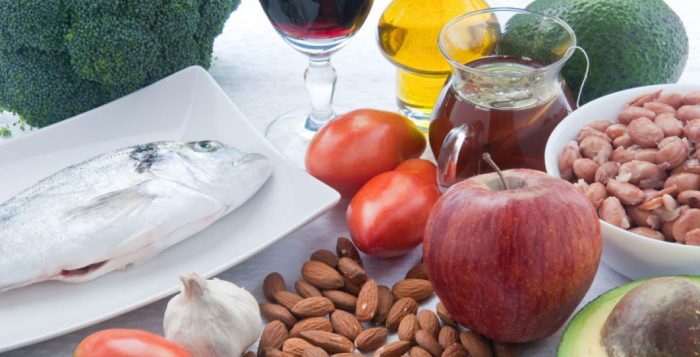For many decades, nutritionists have recommended a balanced diet to provide the body with the proper nutrients to stay healthy. The core components of this diet include vegetables, fruits, grains, proteins, and dairy.
A recent study by researchers at the Harvard T. H. Chan School of Public Health in Boston, MA, provides further evidence for current dietary guidelines and expands on them, finding that consuming at least 2 fruit and 3 vegetable servings on a daily basis may lower the risk of both disease-related death and death from all causes.
The study appears in Circulation, a scientific journal of the American Heart Association (AHA).
Current dietary guidelines
“While groups like the American Heart Association recommend 4–5 servings each of fruits and vegetables daily, consumers likely get inconsistent messages about […] the recommended amount and which foods to include and avoid,” says Dr. Dong D. Wang, M.D., Sc.D., an epidemiologist and nutritionist at Harvard Medical School and lead author of the study.
The Department of Health and Human Services and the Department of Agriculture published their recommendations in the form of the 2020–2025 Dietary Guidelines for Americans.
According to this set of guidelines, half of the plate for every meal should contain fruits and vegetables.
However, the guidelines also note that more than 80% of people in the United States do not meet this recommendation and should aim to increase their consumption of nutrient-dense foods.
Participant dietary information
The researchers collected self-reported dietary information from two large cohort studies: the Nurses’ Health Study (NHS) and the Health Professionals’ Follow-up Study (HPFS).
The NHS cohort included registered female nurses between the ages of 30 and 55 years, while the HPFS cohort included males aged 40–75 years with occupations in the health profession. These studies included follow-ups with the participants every 2–4 years to accumulate dietary information over a span of approximately 30 years.
The researchers excluded participants with baseline heart disease, cancer, or diabetes, leaving them with data from 66,719 females and 42,016 males.
They also incorporated data from an additional 26 studies involving a total of 1.9 million participants, which examined the relationship between fruit and vegetable intake and death rates.
The high participant numbers and continuous longitudinal assessments provided the team with an extensive collection of data for analysis.
However, it is important to note that the criteria of the two cohorts — occupation and corresponding education — suggest a similar socioeconomic status across the participants, who may have been more likely than other members of the population to have access to a healthy diet. The study does not address the realities and effects of food insecurity.
Nutritional values of fruits and vegetables lower risk of death
The study outcomes showed that an increased intake of fruits and vegetables is associated with a lower risk of death, including death due to cancer, heart disease, or respiratory disease.
Additionally, the researchers saw the lowest risk of death at a threshold of a combined 5 servings, beyond which there was no apparent benefit on risk.
These results point to the nutritional value of these foods. For example, higher consumption of fruits and vegetables increases the intake of potassium and antioxidant activity, which link to lower blood pressure and improved lung function, respectively.
As the data are fully self-reported, there may be discrepancies between the actual and reported intakes. Participants with higher intake, in particular, may have tended to overestimate how many servings they consumed.
This margin of error may blur the defined threshold of 5 servings, so the study authors acknowledge that slightly higher servings (up to 10) could also lead to lowered risk.
This study also expands beyond current guidelines by differentiating among specific groups of fruits and vegetables.
The researchers observed trends with a lowered risk of death for leafy greens and foods rich in vitamin C and beta carotene. Fruits and vegetables that fall into these categories include spinach, kale, carrots, and citrus fruits.
Conversely, they did not identify any trends for fruit juices or starchy vegetables, such as potatoes and peas. One possible reason for the latter is the prominence of canned foods. The canning process may deprive starchy vegetables of their antioxidant properties.
Compared with whole fruits, the fluid form of juices may cause a more rapid elevation of blood glucose and insulin levels, which can increase the risk of disease.
In contrast to the existing guidelines, which include canned foods and juices among the recommended foods and drinks, this study calls for further research on the effects of these items on health.
Continued support for ‘5-a-day’ serving recommendation
Rather than being an interventional study, in which researchers directly implement variables and analyze the effects, this study was observational. As a result, it is not possible to conclude that the trends present in this study indicate a causal relationship.
Regardless, there is plentiful evidence that highlights the benefits of a balanced diet containing plenty of fruits and vegetables. The present conclusions also correspond to findings from similar observational studies on the associations between fruit and vegetable intake and disease.
The findings of this study conform to the overall current dietary guidelines to eat at least 5 servings of fruits and vegetables a day. Additionally, it provides further insight into the specificities and benefits of fruit and vegetable intake.

















